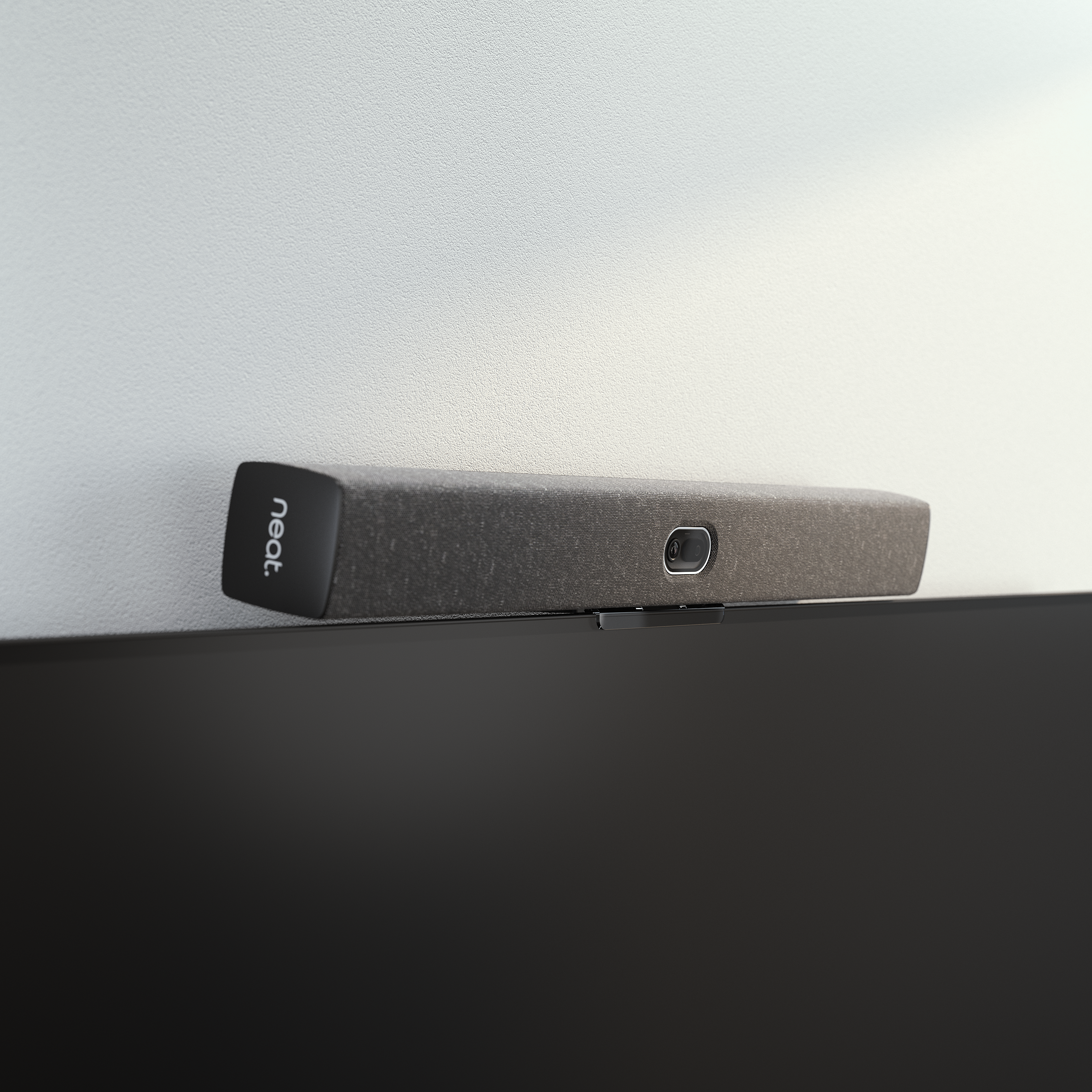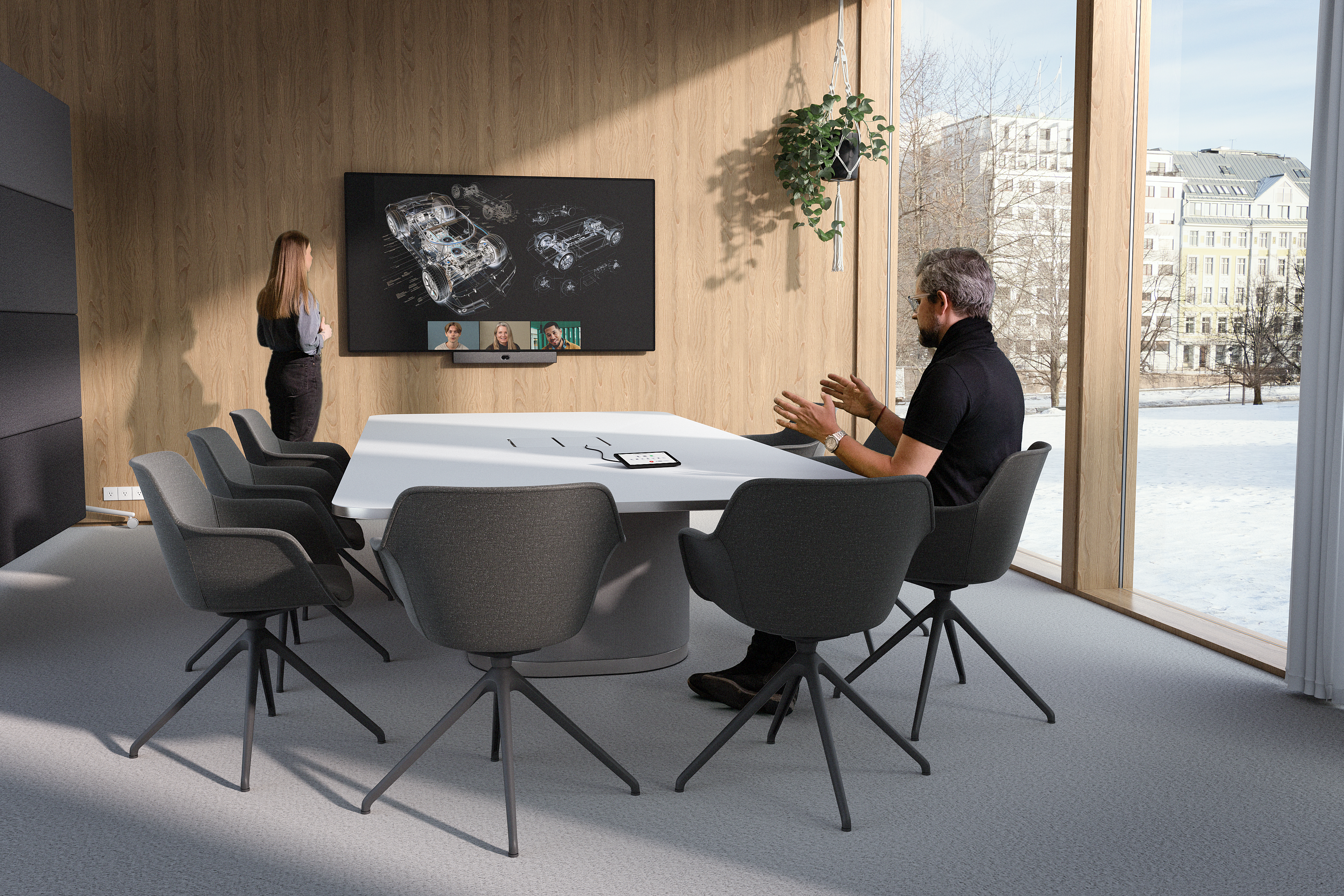Neat, the video device company, today announced the general availability of Neat Bar Generation 2 which plays off the strengths of the Neat Bar that debuted in 2019. According to Norma Lovhaugen, Head of Product Marketing, Strategy & Design for Neat, the company’s first bar “was a very successful product, probably because it's so versatile and can go both in huddle and medium-sized meeting rooms.” Neat has more than 13,000 customers globally.
Fits Neatly in Small- to Medium-sized Meeting Rooms
Neat Bar Gen 2 is likewise designed for small and medium-sized meeting spaces. It can be table- or wall-mounted and despite being slimmer and slightly longer than the original Bar, it will still fit into the first-generation Neat Bar mounts – which means that existing customers can leverage some of their Neat Bar 1 investment if they choose to upgrade. “You swap out the Bar 1, add an additional part and then you click Bar Gen 2 onto the mount,” Lovhaugen said. “It takes about 20 seconds to swap to the new one.”
Neat Bar 1 customers can also take advantage of a new trade-in program that allows customers to request to trade in their Neat Bar 1 or a selection of products from other vendors for the new Neat Bar 2. Neat Bar 2 costs $3,990 and Neat reduced the price of Neat Bar 1 to $2,490.
Neat New Capabilities
Neat Bar 2 includes a 50MP camera (upgraded from a 12MP camera) that can capture an entire meeting space as well as zoom in, frame, and follow multiple people at the same time. Neat Bar 2 has a five-microphone end-fire array, four voice localization tracking mics (two on either side of center) and advanced algorithms for voice enhancement, echo cancellation, deep noise suppression and dereverberation. It includes dual speakers, as well. Neat Bar 2 incorporates machine learning algorithms that learn and adapt to a room’s acoustics and noises, light conditions, layout, and people’s movement.
Additionally, Neat Bar 2 is certified for both Microsoft Teams and Zoom Rooms. “Today, the meeting room AV experience is an optimal combination of hardware, software, and services. Device certifications ensure hardware compatibility and seamless integration with the latest intelligent software development done by Microsoft Teams, Zoom and others,” said Roopam Jain, vice president of Research, Information and Communications Technology at Frost & Sullivan. “Further, these devices have the intelligence to complement the AI features in tandem with the cloud service to best optimize each room experience.”
Part of this room optimization involves support for “bring your own device” (BYOD) which, in this context, means connecting a laptop (via USB-C) to the Neat Bar. “If you have Google Meet and want to run that meeting on the Neat Bar 2, then you just plug in the cable and select the Bar’s camera, microphones and speakers,” Lovhaugen said. “The great part about this is you get our full media stack and AI features.”
These features include Neat Symmetry, which helps focus on whoever’s talking wherever they are (in view of the camera); and Neat Boundary, which allows a meeting space to be configured so the camera will ignore those outside the boundary. “Features like Neat Symmetry and Neat Boundary were among the first intelligent audio-video features to be announced in the market,” said Jain.
“All our devices with a screen have air quality sensors in them,” Lovhaugen said, so although the Neat Bar Gen 2 itself does not have air quality sensors it always comes with a Neat Pad (shown below). The Neat Pad enables touch-screen meeting control and other capabilities.
“We also launched APIs with Neat Pulse so an admin can pull data both on people count and air quality, and then use that to understand how the real estate is utilized,” Lovhaugen said. “Then you can see daily or weekly trends and correlate that with a people count to visualize peaks or troughs during certain hours.”
According to Frost & Sullivan’s Jain, Neat Pulse offers “cloud-based device management for a single-pane-of-glass view across all devices and the new Neat Pulse APIs allow integrators and customers to develop custom solutions that provide deeper insights and tighter management of their meeting spaces.”
(For more on Neat Pulse, check out this post.)
“Our customers really want to modernize their office environment and, in so doing, create a really strong culture,” Lovhaugen said. “They want to create that desire of going back to the office. Having really good equipment there that’s super simple to use will not only further that goal but help make them productive in other ways, as well.”
Want to know more?
No Jitter asked Frost & Sullivan’s Jain a few additional questions regarding the use of A/V equipment, collaboration software and about the “return to office” trend, more generally.
No Jitter (NJ): Many companies likely standardize on a particular collaboration tool (Zoom, Teams, Webex, Slack, etc.) but end up having to support most or all of them. Any thoughts on how that requirement plays out in the real world?
RJ: IT wants to standardize on a single collaboration platform due to complexities with multi-vendor platform implementations and interop. Yet, most customers have more than one collaboration platform running today. This could be driven by their choice for apps deployed on certain platforms (messaging and meetings running over one platform and calling over another, for example) or could be an outcome of their ongoing migration from legacy platforms to new installs. Also, depending on use cases (external calls/external users), cost considerations, and employee preferences – many customers have deployed at least some BYOD rooms or appliances in BYOD mode to give users more flexibility.
NJ: These A/V solutions cost several thousands of dollars. Multiply that out and the cost to equip an office / building / campus / etc., can get expensive very fast – not to mention cabling and/or network upgrades to make sure those rooms have the throughput (and IT support) to function as intended. How are companies approaching the decision to deploy this A/V equipment?
RJ: The total cost of deploying video in meeting rooms has been going up consistently. High costs and budget constraints have been a lingering concern. In 2023, customers took a measured approach to video-enable their meeting rooms, focusing first on bringing employees back to the office. Yet the value of video communications has become deeply entrenched across all industries, creating a rapid uptick in adoption.
Frost & Sullivan forecasts a 5-year unit compound annual growth rate (CAGR) for meeting room video conferencing devices at 13.2%, resulting from the steady trend of video-enabled meeting spaces for hybrid work. The revenue CAGR is a robust 17.7%. The post-pandemic office modernization and tech transformation of businesses is a reality. Business leaders know that if they want their employees to be fully engaged and return to the office, they must invest in technologies that provide a better experience than working from home. A video-first transformation of the enterprise is a key strategic priority.











